NCERT Exemplar Class 7 Science Chapter 9 Soil are part of NCERT Exemplar Class 7 Science. Here we have given NCERT Exemplar Class 7 Science Solutions Chapter 9 Soil.
NCERT Exemplar Class 7 Science Solutions Chapter 9 Soil
Multiple Choice Questions
Question 1.
The microorganisms present in the soil require moisture (water) and nutrients for growth and survival. Choose from the options below the habitat (place) where the soil has plenty of water and nutrients.
(a) Desert
(b) Forest
(c) Open field
(d) Cricket ground
Solution:
(b) In a forest, a large number of deep rooted trees are found. Roots of trees hold soil particles and protect top soil (which contains humus) from getting eroded. Humus makes soil fertile and provides nutrients to growing plants. Trees in a forest act as natural absorbers and help the soil to absorb a huge quantity of the rainwater. So, in forest habitat soil has plenty of water and nutrients.
Question 2.
Availability of water and minerals in the soil for maximum absorption by roots is in the
(a) B-horizon
(b) C-horizon
(c) A-horizon
(d) surface of soil.
Solution:
(c) A – horizon is top soil, rich in humus. Humus improves the texture of soil, increases soil aeration and water holding capacity of soil as well as provides nutrients to the growing plants. This soil layer also contains minerals. Humus and minerals make the soil fertile and favour plant growth.
Question 3.
Soil conservation measures are mainly aimed at pr0tecting which of the following?
(a) Plants
(b) Topsoil
(c) Subsoil
(d) Soil organisms
Solution:
(b): Top soil is rich in humus which is dark brown in colour and consists of decaying remains of plants and animals. Humus improves the texture of the soil and provides nutrients for plant growth. So, it is most fertile region and soil conservation measures are mainly aimed at protecting top soil. If top soil is protected or conserved then subsoil is also conserved because it lies below the top soil.
Question 4.
Read the following statements with reference to soil.
(i) Weathering is a very fast process of soil formation.
(ii) Percolation of water is faster in sandy soils.
(iii) Loamy soil contains only sand and clay.
(iv) Top soil contains the maximum amount of humus.
Choose the correct statements from the above.
(a) (ii) and (iv)
(b) (i) and (iii)
(c) (ii) and (iii)
(d) (i) and (ii)
Solution:
(a): Weathering is the breaking down of huge pieces of rocks into smaller pieces by the action of natural forces such as water, glaciers, wind and roots of plants, etc. It takes hundreds of years to produce a few centimeters of soil. So, it is a very slow process.
Loamy soil is a mixture of sand, silt and clay and also has humus in it.
Very Short Answer Type Questions
Question 5.
Soil has particles of different sizes. Arrange the words given below in increasing order of their particle size.
[ Rock, Clay, Sand, Gravel, Silt ]
Solution:
Clay < Silt < Sand < Gravel < Rock
Question 6.
The components of loamy soil are___,____ and____ .
Solution:
Sand, silt, clay
Question 7.
Read the following statements and give the appropriate terms for each of them.
(a) The process of breakdown of rocks by the action of wind, water, sunlight.
(b) Removal of top soil during heavy rains or strong winds.
(c) Accumulation of wastes in the soil generated by human activity which alter the features of soil.
(d) The process of movement of water into deeper layers of soil.
Solution:
(a) Weathering
(b) Erosion
(c) Soil pollution
(d) Percolation
Question 8.
Unscramble the following jumbled words related to soil.
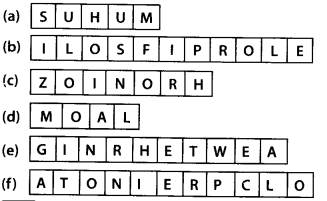
Solution:
(a) HUMUS
(b) SOIL PROFILE
(c) HORIZON
(d) LOAM
(e) WEATHERING
(f) PERCOLATION
Short Answer Type Questions
Question 9.
Which of the following situations – ‘A’ or ‘B’ – is advantageous for absorption of water and minerals? Why?
Situation A: Growth and branching of roots in the C-horizon.
Situation B: Growth and branching of roots in A and B-horizons.
Solution:
Situation B is advantageous to plants because A and B horizons are humus rich regions and humus improves the texture of soil, increases water holding capacity of soil and provides nutrients for the growth of plants. Minerals are also present in A and B horizons. Humus and minerals make soil fertile and help in growth of plants. So growth and branching of roots in A and B – horizons is advantageous for absorption of water and ( minerals by plants.
Question 10.
How can a farmer convert acidic soil to neutral soil?
Solution:
Farmer can convert acidic soil to neutral soil by adding small quantity of quick lime solution or slaked lime solution into the soil.
Question 11.
Is it a good practice to remove grass and small plants that are growing in an open, unused I field? Give reason to support your answer.
Solution:
No. it is not a good practice. Plants cover
the soil surface and their roots bind the soil | particles and hold them in place. During strong winds and rains they protect the top soil and thereby prevent soil erosion.
Question 12.
A man digging a pit found that he could dig with ease initially but digging became difficult as he went deeper. He could not dig beyond a depth of 5 feet. Provide a suitable scientific explanation.
Solution:
The soil surface has loose top soil which is easier to dig. At deeper layers, partially weathered rocks or bedrocks are present | which are hard and make digging difficult.
Question 13.
Locate the following zones given as boxed items in figure 9.1 which shows a diagram of soil profile.
[Topsoil, Subsoil, C-horizon, Bedrock ]
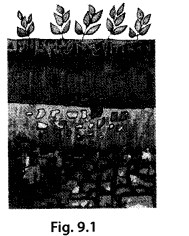
Solution:
The main layers of soil are top soil (A horizon), sub soil (B horizon), parent rock (C horizon) and bedrock which are shown in the given soil profile.
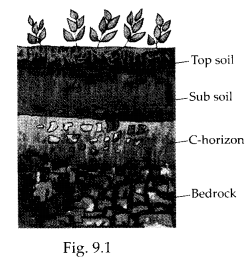
Question 14.
Rajasthan is a desert state in India. Once while traveling to Rajasthan by train, Boojho observed several streams and rivulets of rainwater during the journey but to his surprise he did not see streams of water in the desert region even during rains. Help Boojho find a suitable explanation for this.
Solution:
Deserts are vast stretches of sandy soil. In sandy soil, due to the presence of large spaces between the sand particles, the water drains out quickly. Therefore, sandy soil cannot hold much water and tends to be light and dry. It is because of this reason that in deserts, the falling rainwater immediately percolates downwards in the spaces between sand particles. Due to this, Boojho did not see streams of water in the desert region.
Question 15.
Match the animals in column I with their natural place of dwelling (habitat) in column II
| Column 1 | Column II | ||
| (a) | Earthworm | (i) | Sand and beaches |
| (b) | Garden lizard | (ii) | Burrows in soil |
| (c) | Crab | (iii) | Deep, narrow holes in dry soils |
| (d) | Rodents | (iv) | Surface of soil |
| (e) | Scorpion | (v) | Surface of shaded moist soils |
| (f) | Snails and slugs | (vi) | A horizon of moist soils |
Solution:
(a) (vi)
(b) (iv)
(c) (i)
(d) (ii)
(e) (iii)
(f) (v)
Long Answer Type Questions
Question 16.
Continuously water-logged soils are dis-advantageous for plant growth. Why?
Solution:
Roots, although underground, possess living cells that require oxygen for respira¬tion and production of energy. They absorb oxygen that is present in the spaces between soil particles. But in water logged soils, water occupies the spaces between soil particles and pushes the oxygen out into the atmosphere. Thus, roots are deprived of oxygen and this affects plant growth.
Question 17.
Why is soil erosion relatively less in dense for-ests as compared to barren, open fields?
Solution:
In dense forests, the tree cover (canopy) prevents rainwater from directly falling on the forest floor/soil. The canopy layer of for¬est intercepts the flow of raindrops so that rainwater falls on the leaves of trees and then drips slowly onto the forest floor. Thus, forests allow rainwater to seep. Also roots of the veg¬etation bind the soil particles and hold them firmly. This protects the top soil and prevents it from getting eroded by wind or water. But in barren, open fields the soil is exposed to the wind and falling rain. The soil particles become loose and easily get carried away by blowing wind or flow of water. Hence, soil erosion is relatively less in dense forests as compared to open barren fields.
Question 18.
Gardeners gently dig up the soil around the roots of garden herbs (plants) frequently. Give reasons.
Solution:
Gardeners gently dig up the soil around the roots of garden herbs frequently. This is done
(i) for enabling easy root growth
(ii) for easier percolation of water
(iii) for aerating the soil and enabling air to get into deeper layers of soil
(iv) for removing the weeds.
Question 19.
In towns and cities, generally, the bore wells have to be dug very deep to get water as compared to bore wells dug in villages. Give suitable reasons.
Solution:
In towns and cities, generally, the bore wells have to be dug very deep to get water as compared to bore wells dug in villages. It is so because of the following reasons :
(i) Excessive use of water in towns and cities depletes the groundwater.
(ii) Towns and cities have asphalated roads and vast areas of soil are concreted. As a result, rainwater cannot percolate to recharge groundwater and the groundwater level further decreases. Villages have larger areas of open soil surface and fewer asphalated roads and concrete surfaces. Thus, larger soil surface area is available for rainwater to percolate into the soil easily and recharge the groundwater. As a result, even shallow bore wells yield water in village.
Question 20.
Several terms related to soil are hidden in the squares given as figure 9.2 Spot them and make a list. Two examples are given for you.
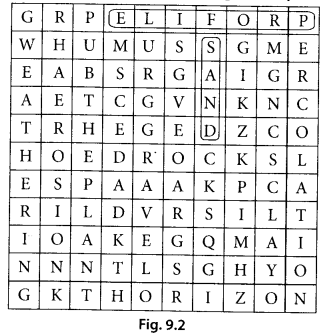
Solution:
The terms hidden in the given word grid are – Profile, Humus, Rock, Silt, Horizon, Weathering, Erosion, Plant, Gravel, Sand, Clay, Percolation, Water and Mineral
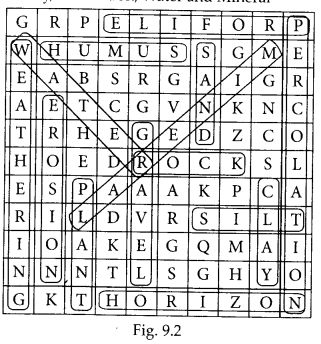
NCERT Exemplar Class 7 Science Solutions
- Chapter 1 Nutrition in Plants
- Chapter 2 Nutrition in Animals
- Chapter 3 Fibre to Fabric
- Chapter 4 Heat
- Chapter 5 Acids, Bases and Salts
- Chapter 6 Physical and Chemical Changes
- Chapter 7 Weather, Climate and Adaptations of Animals to Climate
- Chapter 8 Winds, Storms and Cyclones
- Chapter 9 Soil
- Chapter 10 Respiration in Organisms
- Chapter 11 Transportation in Animals and Plants
- Chapter 12 Reproduction in Plants
- Chapter 13 Motion and Time
- Chapter 14 Electric Current and Its Effects
- Chapter 15 Light
- Chapter 16 Water: A Precious Resource
- Chapter 17 Forests: Our Lifeline
- Chapter 18 Wastewater Story
We hope the NCERT Exemplar Class 7 Science Chapter 9 Soil will help you. If you have any query regarding NCERT Exemplar Class 7 Science Solutions Chapter 9 Soil, drop a comment below and we will get back to you at the earliest.